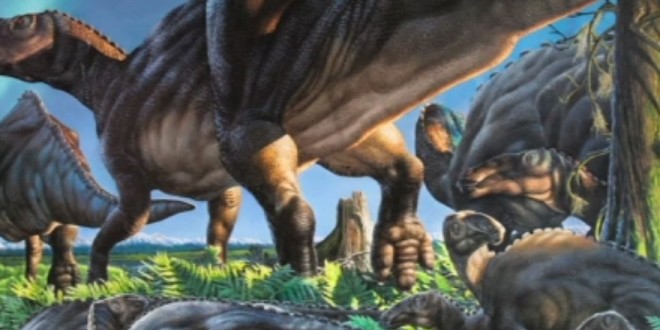A new species of dinosaur that apparently thrived in the cold has been discovered in a remote corner of Alaska.
The creature, Ugrunaaluk kuukpikensis, was a species of hadrosaur that grew up to 30 feet long, lived in herds in the North Slope of Alaska, could thrive in darkness for several months at a time and probably even encountered snow at some point in its lifetime, the researchers explained.
Most of the bones used to identify the new hadrosaur came from the Liscomb Bone Bed, a fossil-rich layer along a river in the Prince Creek Formation (a group of rocks deposited on the Arctic flood plain nearly 70 million years ago), earth sciences curator Pat Druckenmiller and his fellow researchers said. It’s name translates as “ancient grazer.”
New species were northern-most to live in the Cretaceous period
According to Druckenmiller, while the remains were found in the modern-day polar latitudes, the Ugrunaaluk kuukpikensis would have lived even further north during the Cretaceous period – in fact, he added, they were likely “the northern-most dinosaurs to have lived” during this era.
Co-author Gregory Erickson, a Florida State University researcher specializing in the use of bone and tooth histology to interpret dinosaur paleobiology, said that the discovery of a hadrosaur this far north “challenges everything we thought about a dinosaur’s physiology. It creates this natural question. How did they survive up here?”
More than 6,000 bones from the new species have been discovered at the Colville River site, primarily from juveniles believed to be approximately nine feet long and three feet tall at their hips, the study authors reported. Druckenmiller believes that the bones belonged to a herd of young hadrosaurs that had been wiped out suddenly and unexpectedly.
“Ugrunaaluk is far and away the most complete dinosaur yet found in the Arctic or any polar region. We have multiple elements of every single bone in the body,” he said, adding that the discovery “provides further evidence that the dinosaurs living in polar latitudes in what is now Alaska were not the same species found from the same time periods in lower latitudes.”
Agencies/Canadajournal
 Canada Journal – News of the World Articles and videos to bring you the biggest Canadian news stories from across the country every day
Canada Journal – News of the World Articles and videos to bring you the biggest Canadian news stories from across the country every day



